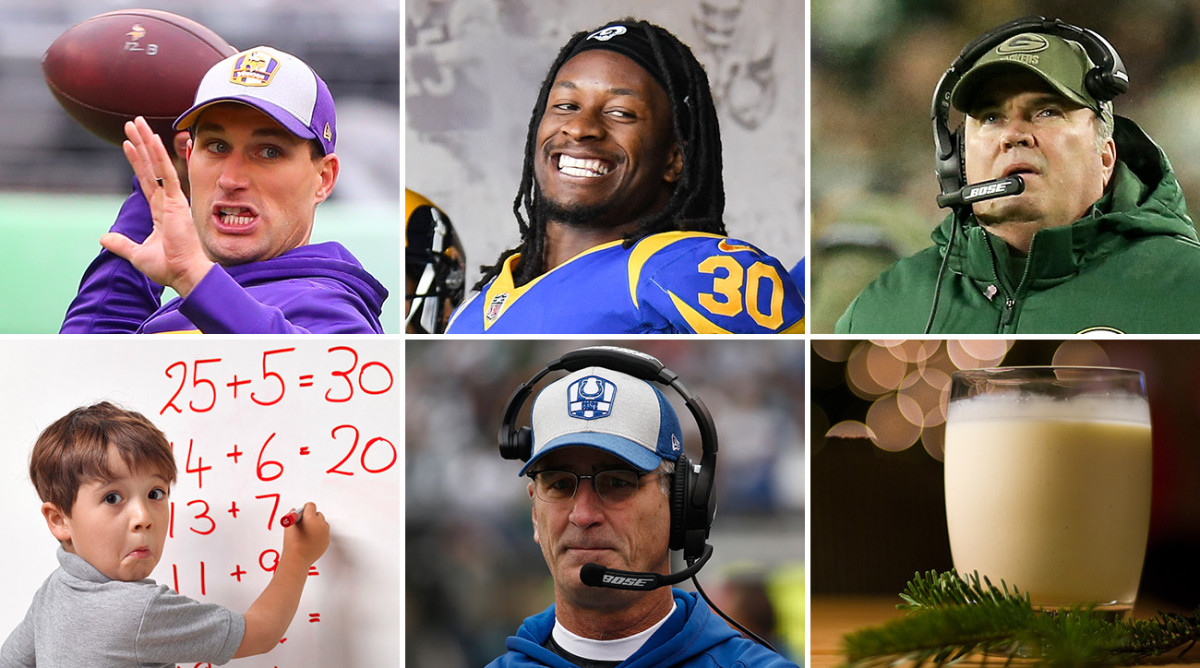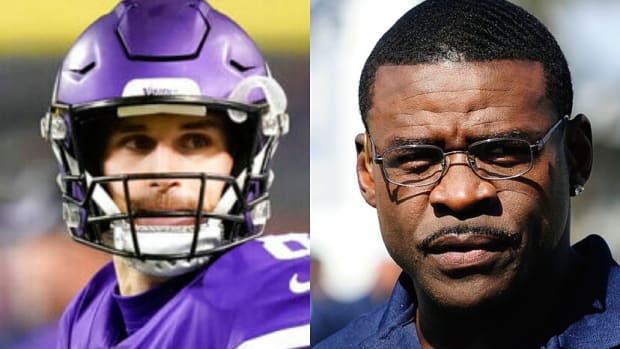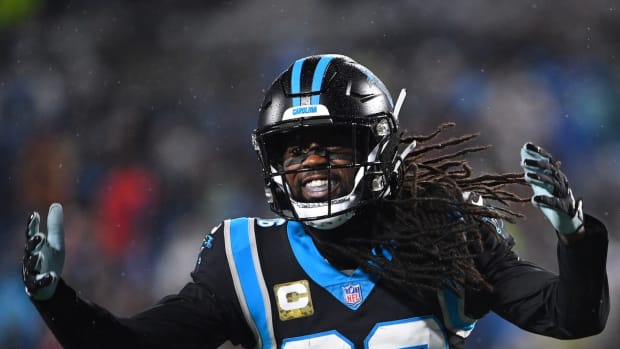Kirk Cousins Can Answer Some Questions in Chicago, a Closer Look at Mike McCarthy ‘Playing the Numbers’

1. Kirk Cousins is an American football quarterback for the Minnesota Vikings of the National Football League (NFL), according to Wikipedia. He’s also a guy who could never get a long-term commitment from Washington in large part because his play was sporadic at all the wrong times. Cousins isn’t thought of as a gunslinger since he doesn’t do a lot of running around and make plays late in the down. But he does take risks—not necessarily a bad thing in the current era—and at times he has put too much trust in his arm, leading to interceptions at the worst possible times.
These days, Cousins is the somewhat newly minted $84 million quarterback for a team that remains on the short list of Super Bowl contenders. Cousins has held up his end of the bargain through nine games, and he recorded a signature, uh, non-loss back in September. But Sunday night, in Chicago, presents the kind of challenge the Vikings brought him in to overcome.
The Bears already have 16 interceptions through nine games, the most in the NFL and twice as many as they had in each of the past three seasons. Part of that is thanks to the ramped-up pass rush (coverage forces sacks, pressure forces turnovers). And part of it is due to the fact that they’ve faced a bizarro murderer’s row of quarterbacks. Among the QBs those 16 picks have come against this season: Nathan Peterman (3), Brock Osweiler (2), Sam Bradford (2), Jameis Winston (2), DeShone Kizer and Ryan Fitzpatrick. It’s fair to wonder whether it’s possible for the Bears to keep taking it away at anywhere near this rate. But if history is any indication, they could have a chance to add to that INT total against Cousins.
Sunday night, on the road against a turnover-happy defense, in a game the Vikings really need to get if they’re going to host a playoff game in January. Cousins comes in walking a fine line between further justifying that fully guaranteed deal by carving up the Bears, or raising more questions about whether he’s the guy to take Minnesota to the next level.
2. There’s nothing much to be said in previewing Monday night’s monster Rams-Chiefs matchup. The Rams’ outside-zone run game out of 11 personnel (three WR, one RB, one TE) presents a nightmare scenario for a Chiefs defense that has always struggled to stop the run with with their sub packages (though my podcast partner/ceramics enthusiast Andy Benoit brings up a good point about why the Rams will miss Cooper Kupp in the run game). Patrick Mahomes’s ability to buy time and create big plays late in the down presents a nightmare scenario for a Rams secondary that has been consistently toasted this year. This game is probably going to swing one way or another on a fluky turnover, though holy crap each of these teams has only lost one fumble on the season (for the Chiefs it was WR Chris Conley, for L.A. it was Todd Gurley). In light of that, we’re probably looking at whomever wins the overtime coin toss coming away with a 62-56 victory.
3. If you’re anything like me, your favorite childhood memories of Sunday morning likely involved getting out of bed and doing math. Lots of math. So let’s have some fun in previewing 6-3 Houston at 6-3 Washington. Lots of fun. So much fun you’ll start to hate fun.
Red-zone performance, like love, is a fickle thing. It’s such a small sample size of plays that it’s difficult to project on a year-to-year basis, let alone a week-to-week basis. The Falcons were the worst red zone offense in the world after the opener, then they were top-five, for most of the year after a ridiculously efficient streak, and now they’ve slid back to 10th overall. That’s the kind of whiplash you get from examining red-zone stats.
The Texans, of course, have had well-documented issues in the red zone, and in that case it isn’t difficult to pinpoint their soggy* offensive line play as a root cause, since it limits their options in the tight red zone. However, the Texans have also been atrocious defensively in the red zone, allowing 5.96 points per red-zone trip, 30th in the NFL. (For context, they ranked 29th a year ago with an injury-ravaged group, but were 20th in 2016, eighth in ’15 and fourth in ’14.) When you look at the league-average of 4.97 points per red-zone trips, Houston has actually scored 21 fewer points than an average team would have under the number of red-zone trips Houston has made, but the Texans have also allowed 23 more points than an average red-zone defense would have. That net -44 points ranks as the second-worst all-around red-zone performance of 2018 (ahead of only Tampa), an average of a five-point swing every week.
Washington, meanwhile, is coming off a victory in Tampa during which they scored only 16 points and, incredibly, won despite allowing their opponent to make six trips inside their 30-yard line. Realistically, even a team having a terrible day would score in the high-teens when taking the ball inside the 30 six times. The fact that the Bucs scored only three points last week is nearly unfathomable. Washington now has a net +20 points over average red-zone performance on the year which, when combined with their meager +1 point differential on the season, well…
“Luck” is a loaded word, so let’s put it this way: You would expect most teams’ red-zone performance to regress to the mean over the course of a season (right? RIGHT?!). Therefore, it’s a whole lot easier to feel good about Houston than Washington at this point. And then you factor in Washington missing both its starting guards, its top deep threat, its all-world left tackle, its two best catch-and-run threats, and is still employing football’s most risk-averse starting quarterback at a time when aggression on offense is resulting in record-setting numbers. Homefield advantage will help, but in short, this might be the most mismatched meeting of 6-3 teams you could imagine.
*—Do people ever refer to offensive-line play as “soggy”? That’s a thing I’d like to start.
4a. After the decision to punt on fourth-and-2, trailing by three, with four minutes, 20 seconds to go and only one timeout left on Thursday night, embattled Packers head coach Mike McCarthy said the Packers were “playing the numbers” when making that decision.
I’ll preface this with a feeble, three-pronged defense of McCarthy. (1) You can’t solely go off spreadsheets on these decisions. You have to consider things like, do you have a play in your pocket that you feel good about? Is the offense playing well, or is their defense dominating (or vice versa, since punting implies you think your defense can force a three-and-out)? (2) The Packers were terrible on third downs on Thursday, and it was not because they were constantly in third-and-long situations. Green Bay was 2-for-8 on third-and-5-or-less due to a combination of questionable play-calling and surprisingly shaky quarterbacking. (3) The Packers have been bad on fourth-and-short in recent seasons, ranking 31st in the NFL on fourth-and-short (three yards or less) since 2014.
But back to those numbers McCarthy referenced: Even at that No. 31 ranking on fourth-and-short, the Packers have still converted 44.4% of the time. Then consider punting then forcing a three-and-out is the only scenario under which the punt decision is defensible. The Seahawks have gone three-and-out on 26.5% of their drives this season, 30th in the NFL. The Packers have forced three-and-outs 22.4% of the time—both numbers are above the league average of 19.8%, so let’s be generous and say McCarthy could ballpark a 30% chance of forcing a three-and-out—the Packers also had the advantage of being able to anticipate running plays on the ensuing drive.
Now, I entered those numbers into the super-computer that takes up most of the space in my garage (admittedly, most of it is balled up aluminum foil and that extra-large 80s microwave I got for making unevenly heated pizza bagels), and it turns out 30% is less than 44%. And then consider that the Packers defense was without Mike Daniels, its best front-seven player. And Kenny Clark, its second-best front-seven player, was playing hurt.
It leaves only one logical confusion: We all misinterpreted McCarthy’s post-game comments. Perhaps “playing the numbers” meant they were playing against the numbers, trying to prove them wrong. OR, perhaps “playing the numbers” referred to the football equivalent of dumping your life’s savings into some combination of Powerball tickets and jai alai bets. But it’s clear it wasn’t in reference to increasing the team’s odds of a victory.
And it’s all a shame. The league forced Green Bay to travel across two time zones on a short week, and McCarthy and his staff had the team ready to play on Thursday. Then they let a lead slip away, and literally punted on their chance to come back.
4b. We all know that the short-sighted money grab that is Thursday Night Football is objectively bad and consistently an embarrassment to the NFL brand due to the fact that professional football isn’t meant to be played on three days’ rest. It’s also getting to a point where it’s fair to wonder if officials also struggle with the short turnaround.
The Week 8 TNF game between Houston and Miami was one of the most poorly officiated in recent memory, with an opening salvo that reached new heights of incredible confusion. The NFL was saved by the fact that Brock Osweiler was under center for the Dolphins and therefore no one watched or really cared. But this past Thursday, a battle between two blue bloods fighting for their playoff lives, brought one of the most egregious non-calls in recent memory.
There have been more blatant penalties go uncalled, but a lot of them were because an official didn’t have the angle, or a slow-motion replay made the infraction even more apparent. But this was as out in the open as you can get with an official positioned, oh, let’s call that 15-20 feet from the action. Wagner—who has absolutely no idea where the ball is—runs through Adams’s right shoulder with a clothesline to boot. It happens a full second before the ball arrives, so early that Adams actually has time to gather himself after the contact and secure the ball; the contact forced the incompletion as Adams is unable to get his second foot down.
On what planet is this not defensive pass interference? I know, I know, you’re going to say COROT-7b, where the molten rock and metal covering the surface would dissuade officials from throwing flags because they burn up on contact and the league really gets on your ass if they have to replace too many of those things. But even on that Earth-like hellscape, this play is flagged 85% of the time.
None of this is to say the Packers would have won on Thursday had the universally accepted and recognized rules of football been applied on this play (Green Bay has proven capable of finding new and exciting ways to lose games). Though the non-call was especially disappointing because it was a pretty neat play, with Adams initially lined up directly behind Rodgers before motioning to the left slot and running an over route. The design completely overwhelmed the Seahawks—Wagner is wonderful, but you don’t want a linebacker running with your opponent’s No. 1 receiver—and the execution after the snap was there, with Rodgers rolling right to buy time and recognizing there was no need to try to make the pass perfect and risk over-throwing his receiver when there was such a wide margin for error. The offense won this play in every way imaginable, making the penalty the only option the defense had to stop the play. Instead, it ended up as Example 53,000 of why Thursday Night Football is the worst.
5. I know he’s technically ineligible to return this season, but I still have this feeling Le’Veon Bell is going to end up playing a big role for the Steelers down the stretch. According to those Scooby-Doo episodes I fell asleep while watching last night, they can do amazing things with masks these days. If a hulking man with a bad haircut and an ax-murderer vibe joins the Steelers backfield in the next two months, watch out.
6. Once again, there’s no reason to fire a head coach in-season to “get a head start” on the hiring process. (However, if you need to rid yourself of a head coach who is making a mockery of your organization, that’s a different story.) A quick look at the teams who were “stuck” making the last hire of the coaching cycle over the last six years:
2018: Colts (Frank Reich)
2017: 49ers (Kyle Shanahan)
2016: Eagles (Doug Pederson)
2015: Falcons (Dan Quinn)
2014: Browns (Mike Pettine)
2013: Cardinals (Bruce Arians)
7. A lot people are all riled up over Patrick Mahomes’s preference for ketchup on mac & cheese, and rightfully so. The only suitable condiment for mac & cheese—or really, any food—is eggnog. It goes well with anything, but if you want a dining pro tip you won’t regret: Eggnog goes best with other eggnog. Mix two different brands of eggnog together (I’ve found Hood and Garelick Farms go well together, but to each his own). Any time I dine out this time of year I bring two or three cartons with me and I usually just order a water. It’s a taste sensation before I’m forcibly removed from the premises.
8. Ladies and gentlemen . . . Queens of the Stone Age!
• Question or comment? Email us at talkback@themmqb.com.





































